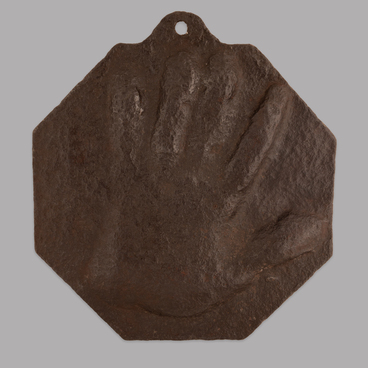A cast-iron plate with an imprint of a hand and an axe is one of the main attractions not only of the Lipetsk Regional Museum of Local Lore, but of the entire Lipetsk Territory. Two legends have been passed down from generation to generation regarding this plate.
According to the first story, Peter the Great discovered an embezzler at the Lipsky factories and ordered to punish him by cutting off the culprit’s hand. The imprint of the axe with which the sentence was allegedly carried out, as well as the imprint of the palm, were placed on a cast-iron plate and hung on the gates of the plant, “so that others would be discouraged” from stealing government money.
The other legend says that the handprint belonged to Peter I himself and it was made when the emperor visited the Lipsky ironworks, which were built by his decree. When examining one of the factories, the tsar stumbled, almost fell and put his hand on the molding sand. The foundry masters decided to commemorate the tsar. They made a plate with an imprint of his hand and an axe, which was Peter I’s favorite tool.
There is also an imprint of a piece of iron ore on the plate. Shallow iron ore deposits were discovered in the Lipetsk region. Therefore, in the early 18th century (from 1703 to 1712) the first ironworks were built in the Lipsky Studenki Maly settlement by decree of Peter the Great.
The local population has long been engaged in metallurgical production, but it was handicraft and did not satisfy the great demand for metal. The emergence of factory metallurgy in the Lipetsk region was caused by the construction of a navy in Voronezh. Factories were needed in close proximity to shipyards to supply ships with metal rigging and weapons.
In the 19th century, the plate with an imprint of a hand and an axe was placed above the entrance to the bath building of the Lipetsk Mineral Waters resort. The resort was officially opened by decree of Alexander I on the territory of former metallurgical plants.
This object entered the collection of the Lipetsk Regional Museum of Local Lore later. In 2016, this imprint was chosen by historians and cultural figures as a symbol of the Lipetsk region as part of the All-Russian project “Where the Motherland Begins.”
According to the first story, Peter the Great discovered an embezzler at the Lipsky factories and ordered to punish him by cutting off the culprit’s hand. The imprint of the axe with which the sentence was allegedly carried out, as well as the imprint of the palm, were placed on a cast-iron plate and hung on the gates of the plant, “so that others would be discouraged” from stealing government money.
The other legend says that the handprint belonged to Peter I himself and it was made when the emperor visited the Lipsky ironworks, which were built by his decree. When examining one of the factories, the tsar stumbled, almost fell and put his hand on the molding sand. The foundry masters decided to commemorate the tsar. They made a plate with an imprint of his hand and an axe, which was Peter I’s favorite tool.
There is also an imprint of a piece of iron ore on the plate. Shallow iron ore deposits were discovered in the Lipetsk region. Therefore, in the early 18th century (from 1703 to 1712) the first ironworks were built in the Lipsky Studenki Maly settlement by decree of Peter the Great.
The local population has long been engaged in metallurgical production, but it was handicraft and did not satisfy the great demand for metal. The emergence of factory metallurgy in the Lipetsk region was caused by the construction of a navy in Voronezh. Factories were needed in close proximity to shipyards to supply ships with metal rigging and weapons.
In the 19th century, the plate with an imprint of a hand and an axe was placed above the entrance to the bath building of the Lipetsk Mineral Waters resort. The resort was officially opened by decree of Alexander I on the territory of former metallurgical plants.
This object entered the collection of the Lipetsk Regional Museum of Local Lore later. In 2016, this imprint was chosen by historians and cultural figures as a symbol of the Lipetsk region as part of the All-Russian project “Where the Motherland Begins.”




